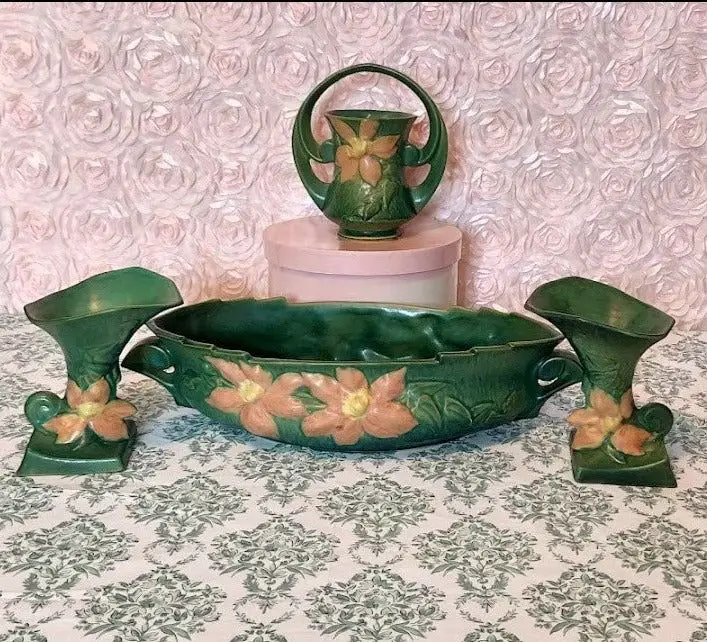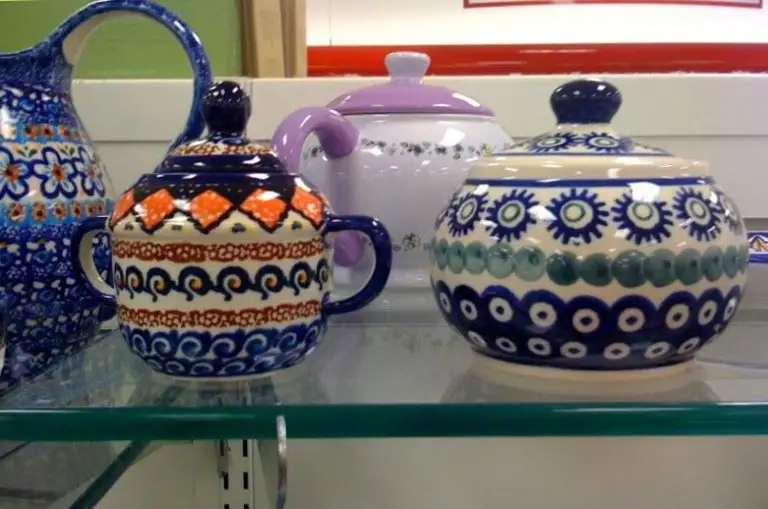What Is The Most Rare Roseville?
The Roseville Pottery Company was founded in Roseville, Ohio in 1890 by George F. Young and J.F. Weaver. For over 60 years, Roseville was one of the largest pottery manufacturers in the world, producing a wide variety of decorative and art pottery (Roseville Pottery Value Guide, antiquesknowhow.com).
Among collectors today, some of the most valuable and sought-after Roseville lines include Pine Cone, Wisteria, Apple Blossom, Clematis, Ferella, Baneda, and Della Robbia. These lines featured bright, vibrant glazes in artistic shapes and designs. The rarest pieces can sell for thousands of dollars at auction (Warmans Roseville Pottery: Identification and Price Guide, Walmart.com).
This article will provide an overview of the most rare and valuable Roseville pottery lines that collectors covet.
Pine Cone Line
The Pine Cone line by Roseville Pottery is considered one of the rarest and most valuable lines they produced. Introduced in 1915, Pine Cone was only in production for two years before being retired in 1917. The line is characterized by a matte green glaze with relief motifs of pine cones and pine branches. Pieces often have a silver or gold painted trim detailing.
Part of what makes Pine Cone so rare and coveted today is its short production window. As it was only made for two years, few pieces were produced relative to other more popular Roseville lines. It was also nearing the end of Roseville’s art pottery era before transitioning to more commercial production, making it one of the last of Roseville’s truly handcrafted art pottery lines.
Some of the most valuable Pine Cone pieces include the console sets, punch bowls, jardinières, and candlesticks. A Pine Cone console set in good condition can easily fetch over $10,000 at auction. Even single pieces like a Pine Cone vase in excellent condition can sell for several thousand dollars.
The Pine Cone line represents the pinnacle of Roseville Pottery’s artistry and short lived production makes it a holy grail for many collectors today.
Wisteria Line
The Wisteria line by Roseville Pottery was produced from 1915 to 1954 and was known for its stylized green wisteria vines and light purple flowers (https://justartpottery.com/collections/roseville-wisteria). This line was inspired by the wisteria plant and included elegant shapes with an Arts & Crafts aesthetic. Some of the rarest and most valuable pieces in the Wisteria line include:
The 1915 Matte Green handled vases – These early matte green pieces are very rare and can fetch $5,000 to $10,000 at auction (https://www.etsy.com/market/roseville_wisteria). They have a beautiful earthy look and display the wisteria pattern.
Azurean pieces – Produced for only one year in azure blue in 1933, these are highly sought after and valued around $2,000 to $4,000.
Early 1900s pottery – Some of the oldest brown glazed earthenware pieces can be worth up to $1,500 due to their age and scarcity.
In general, earlier pieces with unusual glazes and limited production runs bring higher prices for collectors. Clean condition and no damage or repairs also increase value.
Apple Blossom Line
The Apple Blossom line was produced by Roseville Pottery from 1915-1930. It features apple blossom motifs and detailed floral designs. This line was inspired by the apple orchards near Roseville and represents a departure from Roseville’s more geometric Art Deco designs.
Some of the rarest and most valuable pieces in the Apple Blossom line include the squat vases, console bowls, and jardinieres. The 6-8 inch squat vases with detailed hand-painted blossoms can sell for $1,500-$3,000. The low trough-like console bowls are also rare, valued around $2,000-$4,000 depending on size and condition. The jardinieres are popular with collectors, ranging from $1,000 for smaller pieces up to $5,000 for larger, more ornate versions.
In general, the larger and more unique shapes tend to be rarer and command higher prices in the Apple Blossom line. Intricate hand-painted details and colors like cobalt blue and mossy green also make pieces more desirable to collectors. Clean, damage-free examples in excellent condition will fetch the highest values at auction.
Clematis Line
The Clematis line by Roseville Pottery was produced from 1926-1931 and featured beautiful purple and pink clematis flowers. Some of the most rare and valuable pieces in this line include:

- The 9-inch Clematis vase – An extremely rare vase featuring clematis flowers circling the base. Only a few are known to exist today. Valued over $20,000.
- 12-inch Jardinière and pedestal – Large jardinières and their pedestals are hard to find. A 12-inch clematis piece recently sold for over $15,000.
- Clematis candleholders – These elegant candleholders are difficult to find, especially in pairs. They can sell for $2,000-$4,000.
- Console sets – Full console sets with a bowl, candleholders, and tray can command $10,000 or more due to their rarity.
In addition to these rare items, standard Clematis vases in good condition are also highly sought after and can sell for upwards of $1,000.
Ferella Line
The Ferella line was produced by Roseville Pottery from 1929 to 1931 https://justartpottery.com/collections/roseville-ferella. It is considered one of the rarest and most valuable lines Roseville ever produced. The defining characteristics of Ferella pieces are the matte glaze finishes and Art Deco designs featuring flowers, leaves, and geometric patterns.
Only around 150 shapes were produced in the Ferella line, all marked with either a paper label or an impressed mark reading “Ferella.” Pieces came in matte finishes of primarily brown and green, with some blue and yellow pieces also created. The sparse color palette adds to the rarity and collectibility of Ferella.
As one of Roseville’s shortest-lived lines, finding authentic Ferella pieces can be very challenging for collectors. Complete pieces in excellent condition often fetch high prices at auction. For example, a rare 9″ Ferella vase recently sold for over $7,000 https://www.ebay.com/itm/282345547333. Even small Ferella pieces like candleholders can sell for $400-$600 when paired together https://www.etsy.com/market/roseville_ferella. The scarcity and high value of Ferella makes it one of the most coveted Roseville lines for serious pottery collectors.
Baneda Line
The Baneda line was introduced by Roseville Pottery in 1932 and produced until 1954. It is known for its matte green glaze and interesting geometric shapes inspired by Native American designs. Some of the rarest and most valuable Baneda pieces include:
The Daisies pendant vase, produced 1932-1935, features a stylized daisy design and green Baneda glaze. It is extremely rare and can sell for over $4,000. Only a few examples are known to exist (Source).
Large fifteen inch footed urns with swirling geometric designs are also very rare Baneda pieces. These large statement pieces can fetch $3,000 or more at auction if in excellent condition (Source).
Pieces like the 16 inch tall Aztec vase with relief geometric designs tend to value in the $600-$1,500 range. They showcase the intricate hand-painted designs found on many Baneda pieces (Source).
In general, the Baneda line is prized by collectors for its innovative shapes and designs. The matte jade green glaze and Aztec-inspired relief patterns create an eye-catching and unique look. Excellent condition, rare shapes, large sizes, and earlier production dates lead to higher values for Baneda pieces.
Della Robbia Line
The Della Robbia line is arguably the most valuable and rare Roseville pattern. Introduced around 1906, the Della Robbia line features ornate relief molded designs inspired by Italian Renaissance pottery. This decorative style, originating in the 15th century, was revived during the Arts and Crafts movement.
Some of the rarest and most prized Della Robbia pieces feature the Rozane glaze in brilliant hues like cobalt blue, teal, yellow, and green. According to an appraisal on PBS’s Antiques Roadshow, a mint condition Rozane Della Robbia vase could be worth around $3,000. Since the Della Robbia style is so ornate and difficult to produce without flaws, finding pieces in flawless condition is exceptionally rare. Damaged or imperfect examples sell for far lower prices, but pristine museum-quality pieces can fetch thousands of dollars at auction.
The colorful Rozane glazes like mossy green and sapphire blue tend to be the most coveted by collectors and bring the highest prices for Della Robbia wares. However, even the plain green or ivory Della Robbia pieces are considered very valuable due to their ornate handcrafted detailing. According to antique dealers, Della Robbia items priced over $999 are common for rare, high-quality examples of this iconic Roseville line.
Most Valuable Pieces
Some of the most valuable and rare Roseville pottery pieces have fetched astronomical prices at auction over the years. Here are some notable examples:
In 2001, a private collection of Roseville pottery was auctioned by Christie’s and generated over $700,000 in total sales. Some of the top pieces included an 8-inch Pine Cone vase in the Wisteria color palette that sold for $86,000, and a Baneda vase in the Jonquil palette that went for $74,000.
A 14-inch Della Robbia-style vase with an Apple Blossom design sold at auction in 2005 for $258,500. This became the highest price paid at auction for a piece of Roseville pottery at that time.
In 2007, a rare 15-inch Clematis jardinière with a dark green crystalline glaze sold for $431,000 at a Sotheby’s auction. This set a new record for the highest price paid for Roseville pottery.
More recently, in 2018 a 13-inch Rosecraft Zephyr Lily pad bowl with an uncommon glaze combination fetched $300,000 at auction, demonstrating continued demand for rare Roseville pots.
These examples illustrate that the rarest and most unique shapes, sizes, patterns, and glaze treatments command extremely high prices among avid Roseville collectors.
Conclusion
In summary, the rarest and most valuable Roseville pottery lines include the Pine Cone, Wisteria, Apple Blossom, Clematis, Ferella, Baneda, and Della Robbia designs. Specific high value Roseville pieces include the Blackberry candlesticks from the Pine Cone line, the 14-inch Clematis jardiniere and pedestal, and the Della Robbia blue Poppy jardiniere. Factors that contribute to the rarity and value of Roseville pottery include limited production runs of special lines and pieces, unique or innovative glaze techniques, desirable colors and patterns, and pristine condition. As with all antiques, scarcity drives demand. Savvy collectors are willing to pay top dollar for elusive Roseville treasures that stand out with their superb artistry and craftsmanship.


